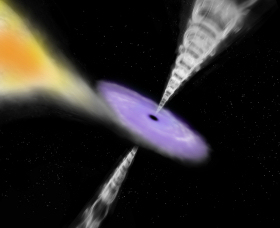Black hole boasts heavyweight jets
13 November 2013
Astronomers studying a black hole in our Galaxy with ESA's XMM-Newton observatory have made a surprising discovery about the cocktail of particles that are ejected from its surroundings.
 |
| Black hole with disc and jets. Credit: ESA/ ATG Medialab |
Stellar-mass black holes are often found feasting on material from a companion star. Matter flows from the star towards the black hole, circling in a disc around it with a temperature so high that it emits X-rays.
The black hole can be a fussy eater: instead of swallowing all of the material, it sometimes pushes a fraction of it away in the form of two powerful jets of particles. Because these jets release mass and energy into the surroundings, the black hole has less material to feed on.
By studying the composition of the jets, we can learn more about the feeding habits of black holes.
Observations at radio wavelengths have already found that black hole jets contain electrons moving at close to the speed of light. But, until now, it was not clear whether the negative charge of the electrons is complemented by their anti-particles, positrons, or rather by heavier positively-charged particles in the jets, like protons or atomic nuclei.
In a new study, astronomers have used XMM-Newton to study a black hole binary system called 4U1630-47, well known to show outbursts of X-rays over periods of months and years.
"In our observations, we found signs of highly ionised nuclei of two heavy elements, iron and nickel," says María Díaz Trigo of the European Southern Observatory in Munich, Germany, lead author of the paper published in the journal Nature.
"The discovery came as a surprise – and a good one, since it shows beyond doubt that the composition of black hole jets is much richer than just electrons."
The team of astronomers observed 4U1630-47 with XMM-Newton on two occasions in September 2012, and compared the results with near-simultaneous radio observations from the Australia Telescope Compact Array.
Although the two sets of observations described by Dr Díaz Trigo and collaborators were separated by only a couple of weeks, the results were surprisingly different.
In the first set of observations, the astronomers detected X-rays from the accretion disc, but did not see anything in radio waves – a sign that the jets were not active.
But in the second set, they detected the source both in X-rays and radio waves, so they knew the jets had been reactivated in the meantime.
When scrutinising the X-ray data from the second batch of observations, the astronomers also found tell-tale signs of iron nuclei moving both towards and away from XMM-Newton, providing confirmation that the ions belong to the two jets, pointing in opposite directions.
The astronomers also found evidence of nickel nuclei in the jet pointing towards XMM-Newton.
"From these 'fingerprints' of iron and nickel, we could show that the speed of the jet is very high, about two-thirds of the speed of light," says co-author James Miller-Jones from the Curtin University node of the International Centre for Radio Astronomy Research in Perth, Australia.
"Moreover, the presence of heavy atomic nuclei in black hole jets means that mass and energy are being carried away from the black hole in much larger amounts than we previously thought, which may have an impact on the mechanism and rate by which the black hole accretes matter," adds co-author Simone Migliari from the University of Barcelona, Spain.
This is the first time that heavy nuclei have been detected in the jets of a relatively typical stellar-mass black hole.
There is only one other X-ray binary that shows similar signatures from atomic nuclei in its jets – a source known as SS 433. This black hole system, however, is characterised by an unusually high accretion rate, which makes it difficult to compare its properties to those of more ordinary black holes.
The new observations of 4U1630-47 will help astronomers learn more about the physical mechanism that launches jets from a black hole's accretion disc.
"While we now know a great deal about black holes and what happens around them, the formation of jets is still a big puzzle, so this observation is a major step forward in understanding this fascinating phenomenon," says Norbert Schartel, ESA's XMM-Newton Project Scientist.
More information
"Baryons in the relativistic jets of the stellar-mass black hole candidate 4U1630-47," by M. Díaz Trigo et al. is published in Nature, 14 November 2013.
For further information, please contact:
Markus Bauer
ESA Science and Robotic Exploration Communication Officer
Tel: +31 71 565 6799
Mob: +31 61 594 3 954
Email: markus.bauer![]() esa.int
esa.int
María Díaz Trigo
European Southern Observatory, Munich, Germany
Email: mdiaztri![]() eso.org
eso.org
Norbert Schartel
XMM-Newton Project Scientist
Tel: +34 91 8131 184
Email: Norbert.Schartel![]() sciops.esa.int
sciops.esa.int
(This article was originally published on ESA's Space Science Portal)

